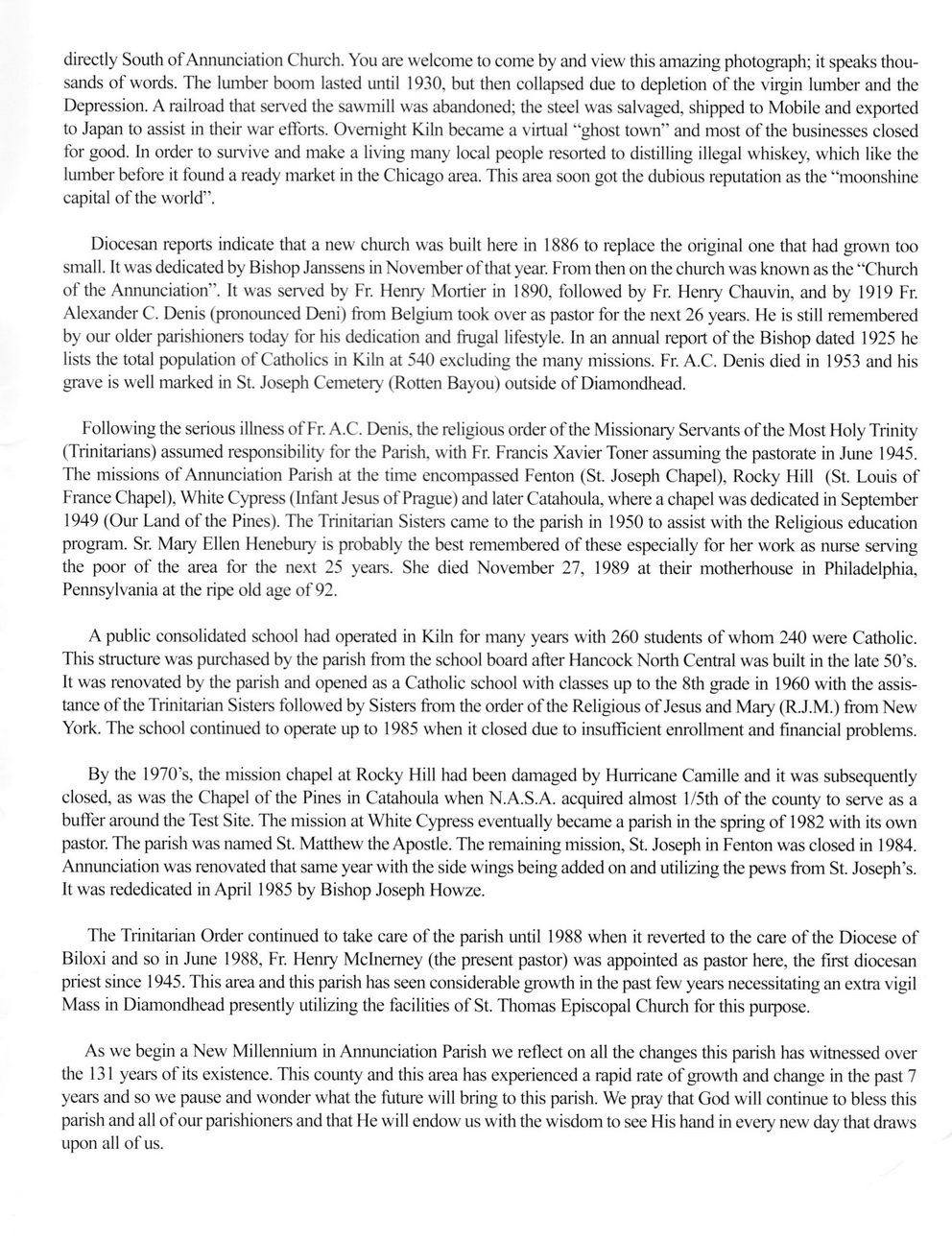This text was obtained via automated optical character recognition.
It has not been edited and may therefore contain several errors.
directly South of Annunciation Church. You are welcome to come by and view this amazing photograph; it speaks thousands of words. The lumber boom lasted until 1930, but then collapsed due to depletion of the virgin lumber and the Depression. A railroad that served the sawmill was abandoned; the steel was salvaged, shipped to Mobile and exported to Japan to assist in their war eiforts. Overnight Kiln became a virtual ?ghost town? and most of the businesses closed for good. In order to survive and make a living many local people resorted to distilling illegal whiskey, which like the lumber before it found a ready market in the Chicago area. This area soon got the dubious reputation as the ?moonshine capital of the world?. Diocesan reports indicate that a new church was built here in 1886 to replace the original one that had grown too small. It was dedicated by Bishop Janssens in November of that year. From then on the church was known as the ?Church of the Annunciation?. It was served by Fr. Henry Mortier in 1890, followed by Fr. Henry Chauvin, and by 1919 Fr. Alexander C. Denis (pronounced Deni) from Belgium took over as pastor for the next 26 years. He is still remembered by our older parishioners today for his dedication and frugal lifestyle. In an annual report of the Bishop dated 1925 he lists the total population of Catholics in Kiln at 540 excluding the many missions. Fr. A.C. Denis died in 1953 and his grave is well marked in St. Joseph Cemetery (Rotten Bayou) outside of Diamondhead. Following the serious illness of Fr. A.C. Denis, the religious order of the Missionary Servants of the Most Holy Trinity (Trinitarians) assumed responsibility for the Parish, with Fr. Francis Xavier Toner assuming the pastorate in June 1945. The missions of Annunciation Parish at the time encompassed Fenton (St. Joseph Chapel), Rocky Hill (St. Louis of France Chapel), White Cypress (Infant Jesus of Prague) and later Catahoula, where a chapel was dedicated in September 1949 (Our Land of the Pines). The Trinitarian Sisters came to the parish in 1950 to assist with the Religious education program. Sr. Mary Ellen Henebury is probably the best remembered of these especially for her work as nurse serving the poor of the area for the next 25 years. She died November 27, 1989 at their motherhouse in Philadelphia, Pennsylvania at the ripe old age of 92. A public consolidated school had operated in Kiln for many years with 260 students of whom 240 were Catholic. This structure was purchased by the parish from the school board after Hancock North Central was built in the late 50?s. It was renovated by the parish and opened as a Catholic school with classes up to the 8th grade in 1960 with the assistance of the Trinitarian Sisters followed by Sisters from the order of the Religious of Jesus and Mary (R.J.M.) from New York. The school continued to operate up to 1985 when it closed due to insufficient enrollment and financial problems. By the 1970?s, the mission chapel at Rocky Hill had been damaged by Hurricane Camille and it was subsequently closed, as was the Chapel of the Pines in Catahoula when N.A.S.A. acquired almost l/5th of the county to serve as a buffer around the Test Site. The mission at White Cypress eventually became a parish in the spring of 1982 with its own pastor. The parish was named St. Matthew the Apostle. The remaining mission, St. Joseph in Fenton was closed in 1984. Annunciation was renovated that same year with the side wings being added on and utilizing the pews from St. Joseph?s. It was rededicated in April 1985 by Bishop Joseph Howze. The Trinitarian Order continued to take care of the parish until 1988 when it reverted to the care of the Diocese of Biloxi and so in June 1988, Fr. Henry Mclnemey (the present pastor) was appointed as pastor here, the first diocesan priest since 1945. This area and this parish has seen considerable growth in the past few years necessitating an extra vigil Mass in Diamondhead presently utilizing the facilities of St. Thomas Episcopal Church for this purpose. As we begin a New Millennium in Annunciation Parish we reflect on all the changes this parish has witnessed over the 131 years of its existence. This county and this area has experienced a rapid rate of growth and change in the past 7 years and so we pause and wonder what the future will bring to this parish. We pray that God will continue to bless this parish and all of our parishioners and that He will endow us with the wisdom to see His hand in every new day that draws upon all of us.

Annunciation Church Kiln 2